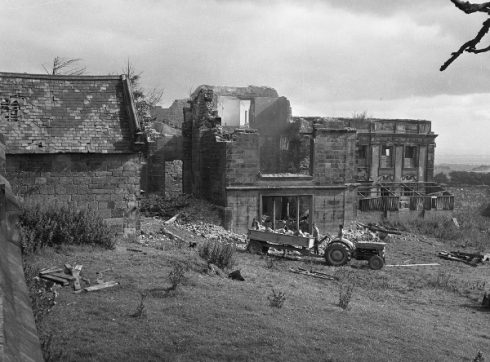You are currently browsing the category archive for the ‘20th century’ category.
There are certain public spaces that seem to define a community as much by their existence in memories and experience as by their physical existence. Brymbo Pool, I suspect, is one of these.
There can be few people locally who have not walked up there on Sundays or summer evenings, rather as many would remember the walk across to Hope Mountain, down Farm Lane to the Hafod, or over to the waterfalls at Nant-y-Ffrith, depending where you lived or how much time you had to waste. I always imagine the pool in bright sunshine, simply because it was where you might go when it was sunny. Nevertheless it has a recorded history too, although early on it becomes as murky as the water has occasionally been.
Recently the Brymbo Heritage Group announced that it was recreating a lost local landmark. Many people who grew up locally will either have known or heard of the isolated grove of twelve trees called (depending on who you asked) the “Twelve Disciples” or “Twelve Apostles”, which once stood on the hillside in the old grounds of the Hall. Like the latter, the trees were removed as a result of coal workings around forty years ago, but they were not forgotten.

The demolition of John Griffith’s 1624 house at Brymbo. (Copyright NWN Media; used under their licence; downloading or commercial reproduction prohibited).
Many of the gentry houses of Britain failed to survive the 20th century. Even the old mansions of Wales, often very different buildings to those attached to the large estates of England, proved in many cases to be just too impractical or expensive to maintain.

Even some farmland in the area has been changed drastically over the years through the effects of mining and industry. The NCB's opencast mine at Brymbo in summer 1974, looking across towards the site of the later steelworks rolling mill.
Grass, hedges and even trees can grow back fairly quickly if left to their own devices. As a result it’s quite easy to look at the more rural parts of our area of study and imagine that the landscape seen today gives a good idea of the surroundings a hundred years ago, or even three hundred years ago.
In fact, the effects of industry and in particular mining have wrought substantial change, making the history of the landscape that much harder to read. Probably the most destructive of these changes was the series of opencast coal workings that were carried out between the end of World War II and the mid 1970s. There are still a few places where you can see field boundaries and lanes much as they appear on, say, the tithe maps of the 1830s: over towards Glascoed or in the valley of the Gwenfro on the township’s southern boundary, for example. But much of the rest of the land in between has been dug over for coal, and with it disappeared all kinds of historical evidence that can now only be seen on maps.
Just a quick post this time; a break from the 18th and 17th century to look at the changes that have occurred even in the past 50 or so years, and a chance to talk about a wonderful photographic archive.
The National Library of Wales has recently begun digitising its huge collection of photographs by the late photojournalist Geoff Charles, who lived in Brymbo. In his time, Charles was one of the most talented and significant photographers working in Wales, and in a lifetime of work for Y Cymro, Farmers Weekly and other publications built up a large library of negatives. Although they cover all areas of Wales, some of these are a record of the area in which he lived.

